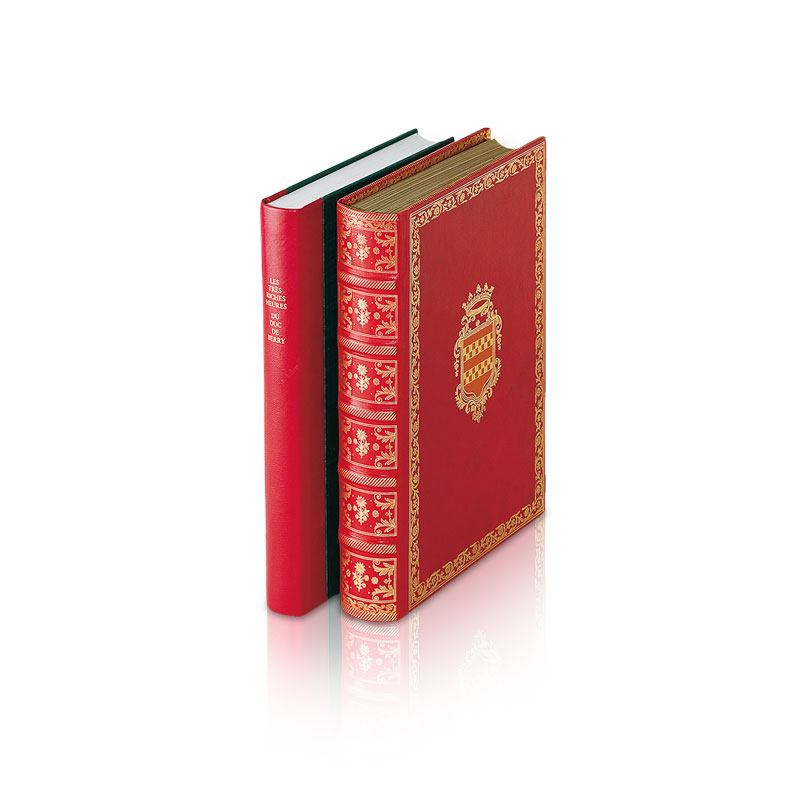Musée Conde, Chantilly, Ms. 65
Les Très Riches Heures du Duc de Berry
This most lavish manuscript ranks among the most famous and precious books of the world and its miniatures among the most beautiful of the Middle Ages. The script is of extreme beauty and clarity and richly decorated with initials and ornamental borders. However, the main feature of the manuscript, which has brought its international renown, are above all the marvellous miniatures in the manner of panel paintings.
After the death of the artists, the manuscript remained incomplete for over 70 years.

Les Très Riches Heures du Duc de Berry
Mysterious History
The Très Riches Heures were made on behalf of the greatest bibliophile of his time, the Duke of Berry, around 1410. When he died in 1416, work on the book was interrupted. The then incomplete and unbound manuscript was handed down to the House of Savoy, to Duke Charles I who inherited the lavishly decorated work and ordered its completion.
Its path is then lost in the mist of times. The manuscript later reappears in the middle of the 19th century in the library of an Italian baron who sold it to the due d’Aumale. After de fall of Napoleon III, the manuscript came to France where it is kept today at the Château de Chantilly and now belongs to the Institut de France.
Les Très Riches Heures du Duc de Berry
Musée Conde, Chantilly, Ms. 65
Panel painting in book form
This most lavish manuscript ranks among the most famous and precious books of the world and its miniatures among the most beautiful of the Middle Ages. The script is of extreme beauty and clarity and richly decorated with initials and ornamental borders. However, the main feature of the manuscript, which has brought its international renown, are above all the marvellous miniatures in the manner of panel paintings.The artists who participated in the execution of this magnificent book are well known: the Limbourg brothers and Jean Colombe were great masters of their times. Executed between 1410 and 1485 this unique work with its innovatory spirit and bold artistic approach clearly outdid everything hitherto know.
The Artists - Outstanding Masters of Their Times
The Duke of Berry entrusted the Limbourg brothers, who had worked in the bibliophile’s services since 1404, with the execution of this manuscript.
The art of the brothers Pol, Herman and Jean Limbourg was unique, its special character forbidding any imitation. Their work always represented and still remains to this day a landmark of Occidental painting. However, after their sudden death in 1416, the manuscript was left incomplete.
The manuscript remained unfinished for quite some time until in 1485 Jean Colombe continued to work on it on the initiative of the Due of Savoy. The artist clearly admired the Limbourg brothers’ style but refused to imitate it and developed his own style in accordance with the currents of his times. The calendar leaves in particular have not yet been fully attributed to a particular artist. Art historians speak of another “intermediary painter” who could have completed some of the calendar illustrations around 1440, however, this theory has never been fully confirmed.
The Four Seasons of the Duc de Berry
The facsimile of the Très Riches Heures is no longer available as of today. However, Faksimile Verlag has an elaborate edition of The Four Seasons of Duc de Berry to offer. 12 superb leaves showing all months of the year as well as the corresponding manuscripts are presented in a sumptuous box. A lavishly illustrated booklet describes the manuscripts as well as the leaves.
The leaves are presented in a precious linen-covered box decorated with the arms of the bibliophile duke. The 12 leaves can also be used as an exclusive wall decoration since all folios are framed in passe-partouts.
The Fine Art Facsimile Edition
The facsimile of this luxurious manuscript covers 416 pages in the format of 29 x 21 cm and includes 131 miniatures, all richly decorated with silver and gold as well as over 3.000 gold initials.
The facsimile was published in a unique edition with only 980 copies which has been completely sold out.
The commentary volume
The commentary volume of 435 pages describes the manuscript and its historical and artistic background in full detail in German, English, and French and comprises a full transcription of the text.



